![]()
![]()
![]()
Use LEFT and RIGHT arrow keys to navigate between flashcards;
Use UP and DOWN arrow keys to flip the card;
H to show hint;
A reads text to speech;
50 Cards in this Set
- Front
- Back
- 3rd side (hint)
|
Red nucleus
|
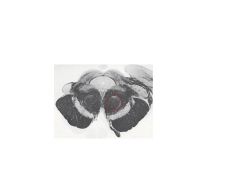
What area is tagged?
|
|
|
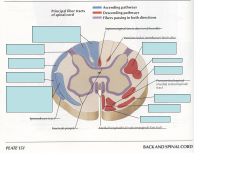
Name the tract(s) within the green tags. For larger boxes, there are more than one tract.
|

See the drawing for the labeled tracts.
|
Andy teaches Vern poorly regularly
|
|
|
Draw a basic/generalized circuit within the cerebellum.
|
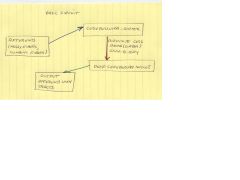
See the drawing.
|
|
|
|
Draw out the circuit for the vestibulocerebellum.
|
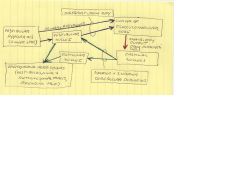
See the image.
|
|
|
|
Draw out the cerebrocerebellum circuit.
|

See the drawing.
|
|
|
|
Draw out the Spinocerebellum circuit which has an influence on axial mm and limb extensions. (postural/antigravity mm)
|
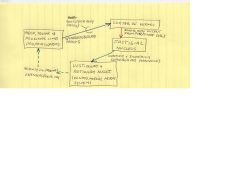
See the drawing.
|
|
|
|
Draw out the Spinocerebellum circuit - Influence on flexors/distal limb mm
|
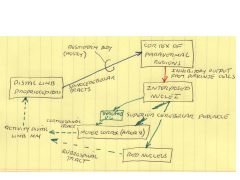
See the drawing.
|
|
|
|
What are the four spinocerebellar tracts?
|
Rostral spinocerebellar
Cuneo-cerebellar Ventral & Dorsal Spinocerebellar |
|
|
|
What is the source of information carried by each of the four spinocerebellar tracts?
|
Proprioceptive receptors - same as used for DCML.
|
|
|
|
Where does the ventral and dorsal spinocerebellar tract decussate?
|
The ventral spinocerebellar tract decussates at the cord level and again in the pons area. The dorsal spinocerebellar tract does not decussate.
|
|
|
|
For the two spinocerebellum tracts (ventral and dorsal), what does each influence in the body?
|
1) Ventral - Flexors/distal limb mm
2) Dorsal - Axial mm and limb extensions (postural/antigravity mm) |
|
|
|
What peduncle(s) is used for the dorsal spinocerebellum tract (DSCT)?
What peduncle(s) is used for the ventral spinocerebellum tract (VSCT)? |
Dorsal - Inferior cerebellar peduncle
Ventral - Superior cerebellar peduncle. |
|
|
|
What are the major inputs of the dorsal spinocerebellar tract?
|
Mechanoreceptors in muscles, joints, skin.
|
|
|
|
What are the major inputs of the ventral spinocerebellar tract?
|
Mechanoreceptors, movement-related interneurons.
|
|
|
|
What are the major inputs of the cuneocerebellar tract?
|
Mechanoreceptors in muscles, joints, skin.
|
|
|
|
What is the origin of the dorsal spinocerebellar tract?
|
Clarke's nucleus (T1-L2/3).
|
|
|
|
What is the origin of the ventral spinocerebellar tract?
|
Spinal boarder cells (T12-L5)
|
|
|
|
What are the two most common characteristics observed for cerebellar disease?
Give a definition for each. |
Hypotonia: diminished muscle tone.
Ataxia: inability to coordinate movements and maintain posture. Can intefere with walking, talking eating, etc. |
|
|
|
What is dysmetria?
|
The inability to place an extremity at a precise point in space.
|
|
|
|
What is intention tremor?
|
A tremor that arises when VOLUNTARY movements are ATTEMPTED.
|
|
|
|
What is dysdiadochokineses?
|
Difficulty in making rapidly alternative or successive movements, e.g. clamp hand to other palm to palm then back to palm, etc.
|
|
|
|
What is rebound phenomenon?
|
A loss of the normal checks of agonist and antagonist muscles.
|
|
|
|
What is truncal sway?
|
Sway from side to side when standing.
|
|
|
|
What is Nystagmus?
|
Involuntary, rapid movement of the eyes in either the horizontal direction or occasionally in the vertical direction.
|
|
|
|
What is delayed initiation of movement?
|
As it says. There is delay before movement begins.
|
|
|
|
What are pendular reflexes?
|
When doing a reflex test, may see a swinging of a limb, e.g. leg, rather than one quick jerk.
|
|
|
|
What is past pointing?
|
Individual reaches target and continues movement after reaching it, e.g. finger to nose pointing but keeps moving finger around nose after reaching it.
|
|
|
|
What is dysarthia?
|
Scanning or explosive speech pattern. Person is unable to coordinate air movements with muscles of speech.
|
|
|
|
Define the characteristics of vestibulocerebellar syndrome. What is a critical test of absence?
|
Ataxia, wide-based stance, nystagmus. The patient does not show ataxia symptoms when lying down.
|
|
|
|
What is the primary function of the vestibulocerebellum?
|
Coordinates proximal mm., maintains body posture/balance, coordinates eye movements
|
|
|
|
What is the primary function of the spinocerebellum?
|
Bring proprioceptive information to cerebellum.
|
|
|
|
What is the primary function of the cerebrocerebellum?
|
Timing, planning of complicated movements.
|
|
|
|
Define the characteristics of Cerebrocerebellar Syndrome.
|
Ataxia
•Delay in initiation & termination of movements •Decomposition of complicated movements •Dysdiadochokinesia |
|
|
|
Define the characteristics of Spinocerebellar (Anterior Lobe) Syndrome
1) What degenerates? 2) What limb is involved? 3) Signs What is a cause? |
•Degeneration of anterior lobe
• pelvic limb involvement •Broad-based stance •Shuffling, staggering gait •Ataxia not relieved by recumbency (not a problem w/gravity) •Chronic Alcoholism |
|
|
|
What are the functional divisions of the Cerebellum
Spinocerebellum? |
•“Essential for performance of smooth, accurate, & coordinated motor tasks.” •Modulation of Ongoing Motor Activity:
Rate, Range, and Force of Voluntary Movements |
|
|
|
What is an analogy for the function of the Cerebellum Spinocerebellum?
|
It acts like a comparator. Plan versus actual movement.
|
|
|
|
What are the primary afferents or efferents of the superior, middle and inferior peduncles?
|
Superior - cerebellar output and a little input.
Middle - input - Pontocerebellar Fibers Inferior - input - Spinocerebellar Tracts, vestibular and olives. Slight output to vestibular. |
|
|

Fill in the names in the green boxes.
|

See picture.
|
|
|
|
Molecular layer.
Purkinje cell layer. Granule cell layer. Synaptic internrons between cerebellar interneurons and Purkinje cells. The molecular layer is next to the pial layer of the cerebellum cortex. |

Name the three areas shown in the picture from top to bottom.
What is contained in the top layer? Where is the top layer located in relationship to the cerebellum? |
|
|
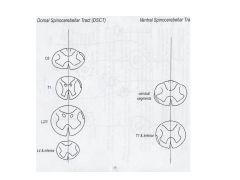
Sketch the DSCT tract including an afferent that enters at L2/3 and one that enters at L4.
Sketch the VSCT tract. What is the name of the nucleus circled in the DSCT spinal cord? |

See the picture for the tracts.
Clarke's nucleus. |
|
|
|
What are the first degree functions of the cerebellum?
|
1. Control of rate, range, & force of ongoing motor movements ("coordintation")
2. Maintenance of stable posture 3. Planning & timing of complex movements. |
|
|
|
In a simple explanation, how does the cerebellum accomplish its first degree functions?
|
By adjusting the output of UMN pathways.
|
|
|
|
What two things does the cerebellum not do?
|
Issue motor commands or act in awareness of stimuli.
|
|
|
|
What two things are not charactistics of cerebellar disease?
|
1. Is not characterized by paresis or paralysis.
2. Is not characterized by a loss of sensory function. |
|
|
|
Arbor Vitae
|
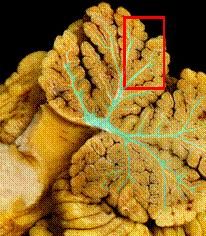
What is the name of the structure shown in light blue?
|
|
|
|
What are the three functional divisions of the cerebellum?
|
Vestibulocerebellum
Cerebrocerebellum Spinocerebellum |
|
|
|
What are the functions of the spinocerebellum?
CHECKOUT QUESTION VS ANSWER |
1) "Essential for performance of smooth, accurate, & coordinated motor tasks."
2) Modulation of Ongoing Motor Activity: Rate, Range, and Force of Voluntary Movements |
|
|
|
What are the four spinocerebellar tracts from the cord?
|
1) Rostral (cranial) spinocerebellar & cuneocerebellar tracts from upper limb.
2) Ventral & Dorsal Spinocerebellar tracts from lower limb |
|
|
|
What are the vestibulocerebellar syndromes?
Why do these signs appear, i.e. what control has been lost? When are the signs not observed? |
Ataxia
Wide-based stance Nystagmus ("jerk", especially w/lateral gaze) Signs result from inability to use vestibular information to coordinate movements. No deficits are seen when patient is recumbent. |
|
|
|
What are the cerebrocerebellar syndromes?
|
Ataxia
Delay in initiation & termination of movements. Decomposition of complicated movements Dysdiadochokinesia |
|

